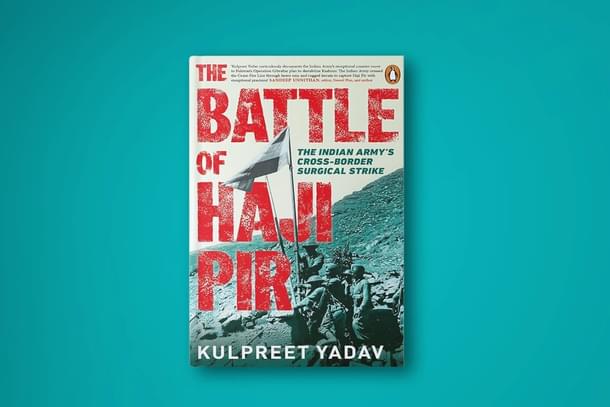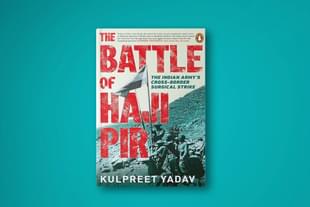Books
1965 Independence Day Orders: The March Towards Haji Pir
Kulpreet Yadav
Aug 15, 2024, 11:35 AM | Updated 11:34 AM IST
Save & read from anywhere!
Bookmark stories for easy access on any device or the Swarajya app.


The Battle of Haji Pir: The Indian Army’s Cross-Border Surgical Strike. Kulpreet Yadav. Penguin. Pages 256. Rs 281.
At the headquarters of 1 Para Battalion, Maj. Ranjit Singh Dyal, the 2 i/c of the battalion, was conducting an operations briefing. All officers, including the commanding officer, were present in the SMR. The JCOs of the four companies (Alpha, Bravo, Charlie and Delta) were present too.
Maj. Ranjit Singh Dyal had a wooden stick in his hand. He asked, ‘Sir, do I have your permission to start?’
Lt Col Prabjinder Singh, the commanding officer, replied, ‘Before you begin, Major Dyal, I want to address the leaders of our battalion.’
Everyone stared back at him without emotion, as Maj. Dyal stepped to one side.
The CO started to speak, ‘First of all, happy Independence Day to you once again. After the morning parade, we should have observed a holiday today, but the developments in our area won’t let us rest. As you know, Pakistani infiltrators have entered the Valley and they are targeting the Army’s and government’s infrastructure. Since 5 August, many of our officers, JCOs, jawans and Kashmiri brethren have lost their lives. The infiltrators are also trying to shift the loyalties of the Kashmiri people, our brothers and sisters, to their side by spreading rumours. In doing so, however, from what I have been told, they are having little success.’
He paused, looked at the faces of all present one by one and continued, ‘But when people are not following their orders, the Pakistanis are using the fear of guns, and it seems to be working in some pockets. The brigade commander spoke to me this morning. Though the formal orders have not yet been received, he feels we will be deployed across the CFL in the Haji Pir area soon. If these orders indeed come, it will be a god-sent opportunity for us and we will strike to kill. Clear?’
‘Yes, sir!’ everyone shouted back, eyes wide, jaws firm and backs straight.
The CO turned towards the 2 i/c and said, ‘You may continue now, Major Dyal.’
Maj. Dyal stepped forward again and replied, ‘Yes, sir. So, as the CO has said, we will strike to kill. Now, I know some of you are new in this area, but I have been here for the last three years. Let me give you an overview. To understand the peculiarity of the Haji Pir area, it is important to take a look at this sand model carefully.’
All eyes shifted to the sand model and he continued, ‘As you can see, the town of Uri is located on the northern side of the bulge and the town of Poonch is located on the southern side of the bulge. Before 1947, a 41-kilometre-long road connected the towns of Uri and Poonch. The time required to travel in a vehicle from one town to the other at that time used to be around two hours. But, after Pakistan’s unauthorized occupation of the area now known as POK and establishment of a CFL mediated by the UN, the entire bulge unfortunately came under Pakistan control. Consequently, the distance between Uri and Poonch is now 500 kilometres all the way via Jammu, and it takes more than a day to travel from one town to the other.’
All eyes scanned the sand model as Maj. Dyal continued, ‘There’s an interesting history attached to the Haji Pir Pass. It is believed that once, when Shahjahan, the fourth Mughal emperor who ruled the majority of the Indian subcontinent from 1628 to 1658, was crossing the area with his caravan on his way to Srinagar from Rawalpindi, he had a vision. In this vision, he saw a small mazaar (shrine) of a pir (saint). After waking up, he climbed up there and guess what he found.’
He paused, smiled and continued, ‘Yes, a mazaar that was exactly the way he had seen in his dreams. The emperor was believed to be the first person to pay his respects to the pir by tying a string on a tree there. Good, so far?’
Everyone nodded and Maj. Dyal continued, ‘From history, let us come to hard facts now. The Haji Pir bulge has several peaks and our intelligence has confirmed that these are occupied by the enemy in platoon-size and company-size strengths. The pass itself is around 8 kilometres across the CFL in Pakistani territory. To capture these hill features will be a daunting task, but the only way we can reach the pass is by knocking down these tactically strong positions occupied by the enemy. We will have to go for the kill in a coordinated way, not just with our companies, but also with the other battalions of our brigade.’
After this, each and every peak, the nallahs, the contour lines, the approaches and other aspects of the terrain were discussed in detail. The officers and the JCOs also pitched in with their questions and comments.
The CO looked at the involvement of all the leaders under his command. He had no doubt that when the time came, the tigers of 1 Para Battalion would shatter the enemy to pieces.
At the corps’ headquarters, Lt Gen. Kashmir Singh Katoch was worried. Even with the creation of the Sri Force, the enemy was attacking the Army’s and the state government’s infrastructure at will. The XV Corps was fighting well, but the sheer number of the enemy foot soldiers was overwhelming. His intelligence assessment continued to indicate that almost 50,000 infiltrators had entered Indian territory and were using the local people for cover and provisions.
To make matters worse, the GOC-in-C had been insistent about crossing the border (CFL) for a strike. That would stretch his limited resources thinner, and it wouldn’t be possible for the corps to maintain the supply line to such a spread-out terrain. The enemy was not in front of them, but was all around them. The infiltrators were also invisible, because they were not wearing combat uniforms but were wearing salwar kameez like the civilians. It was impossible to tell one from the other.
After a lot of thinking and deliberations with the officers at his corps headquarters, Lt Gen. Katoch decided to formally convey his apprehensions to his boss in the form of an official signal communication. He wanted to be sure that if things indeed went out of hand, as he suspected they would, this official signal would prove to everyone that he had put his foot down and had said no to crossing the border. Therefore, a short signal was prepared and communicated to the Army Commander, Lt Gen. Harbaksh Singh, in Shimla, with a copy marked to the Chief of Army Staff, Gen. J.N. Chaudhuri, in New Delhi.
When Lt Gen. Harbaksh Singh received the signal in Shimla, he was angry. The Corps Commander was challenging his military wisdom. This was tantamount to insubordination and therefore, he immediately called and discussed the matter with the Army Chief. The Army Chief gave him a go-ahead.
Consequently, the next morning, that is, on 17 August 1965, the command headquarters gave official orders to XV Corps to cross the CFL and capture the Haji Pir Pass. This was no longer a matter of discussions and deliberations. It was an order now.
With that, all Lt Gen. Katoch’s reservations were put to rest and the XV Corps, like a well-oiled war machine, started to gear up for action.
According to the orders, XV Corps were to approach the Haji Pir bulge from two directions as a ‘pincer attack’. From the north at Uri, acting as the upper claw, 19 Division was ordered to use 68 Brigade for the thrust. This operation was called ‘Operation Bakshi’.
From the south at Poonch, acting as the lower claw, 25 Division was ordered to use 93 Brigade for the thrust. This was called ‘Operation Faulad’.




